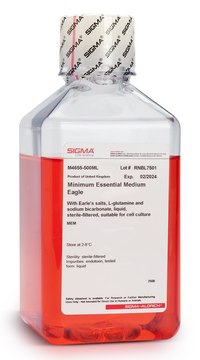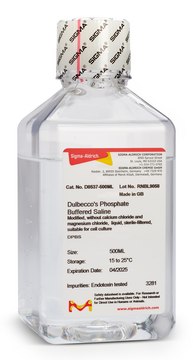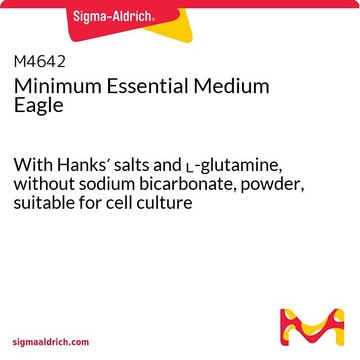51412C
Medio esencial mínimo Eagle
with Earle′s Balanced Salts, without L-glutamine, liquid, sterile-filtered, suitable for cell culture
Sinónimos:
MEM
Iniciar sesiónpara Ver la Fijación de precios por contrato y de la organización
About This Item
UNSPSC Code:
12352207
NACRES:
NA.75
Productos recomendados
description
for research or for further manufacturing use
sterility
sterile-filtered
form
liquid
technique(s)
cell culture | mammalian: suitable
cell culture | stem cell: suitable
components
L-glutamine: no
NaHCO3: 2200 mg/L
phenol red: 10.62 mg/L
Earle’s salts (5% CO2): yes
storage temp.
2-8°C
¿Está buscando productos similares? Visita Guía de comparación de productos
General description
Minimum Essential Medium (MEM) with Earle′s Balanced Salts was developed by Harry Eagle as a result of his studies to determine the essential nutritional requirements of mouse L cells and HeLa cells in culture. He demonstrated that these cells require 13 amino acids and seven vitamins to grow and reproduce in vitro. MEM is a modification of Eagle′s earlier medium Basal Medium Eagle (BME), containing higher concentrations of the essential nutrients. This medium has demonstrated the ability to support a variety of normal and transformed cells in culture and contains Earle′s Balanced Salts, which makes it suitable for use in atmospheres charged with CO2 gas.
Application
Minimum essential medium (MEM) has been used as a growth medium for bone marrow mesenchymal stem cells (BMSCs) and neurons.
supplement
Storage Class
12 - Non Combustible Liquids
wgk_germany
WGK 1
flash_point_f
Not applicable
flash_point_c
Not applicable
ppe
Eyeshields, Gloves
Elija entre una de las versiones más recientes:
¿Ya tiene este producto?
Encuentre la documentación para los productos que ha comprado recientemente en la Biblioteca de documentos.
Los clientes también vieron
A novel pulsed STED microscopy method using FastFLIM and the phasor plots.
Sun Y, et al.
Proceedings of SPIE (2017)
Involvement of microRNA-23b in TNF-?-reduced BMSC osteogenic differentiation via targeting runx2.
Deng L, et al.
Journal of Bone and Mineral Metabolism, 1-13 (2017)
Debora Soncini et al.
Blood advances, 4(18), 4312-4326 (2020-09-12)
Metabolic reprogramming is emerging as a cancer vulnerability that could be therapeutically exploitable using different approaches, including amino acid depletion for those tumors that rely on exogenous amino acids for their maintenance. ʟ-Asparaginase (ASNase) has contributed to a significant improvement
Agata Nowacka et al.
Scientific reports, 10(1), 2054-2054 (2020-02-08)
PSD-95 is a major scaffolding protein of the post-synaptic density (PSD) of a glutamatergic synapse. PSD-95, via interactions with stargazin, anchors AMPA receptors at the synapse and regulates AMPAR currents. The expression of PSD-95 is regulated during synaptic plasticity. It
Dirk M Reiter et al.
PLoS pathogens, 7(8), e1002166-e1002166 (2011-08-11)
Many viruses attach to target cells by binding to cell-surface glycans. To gain a better understanding of strategies used by viruses to engage carbohydrate receptors, we determined the crystal structures of reovirus attachment protein σ1 in complex with α-2,3-sialyllactose, α-2,6-sialyllactose
Nuestro equipo de científicos tiene experiencia en todas las áreas de investigación: Ciencias de la vida, Ciencia de los materiales, Síntesis química, Cromatografía, Analítica y muchas otras.
Póngase en contacto con el Servicio técnico



